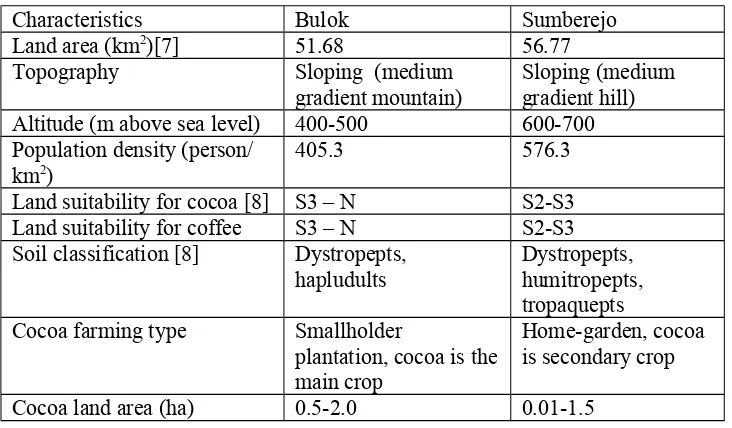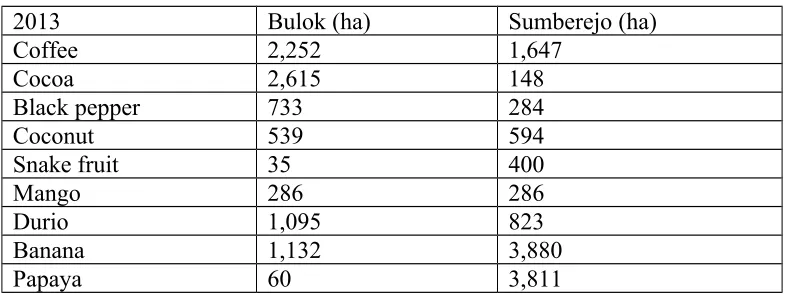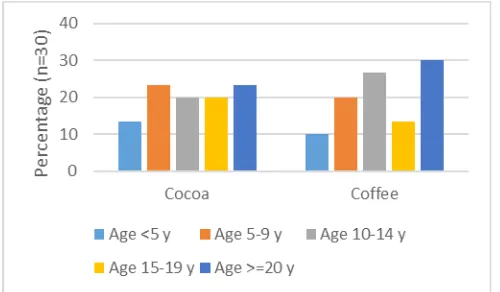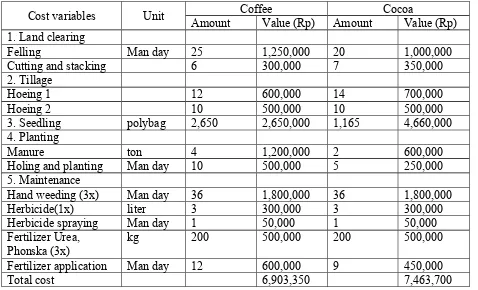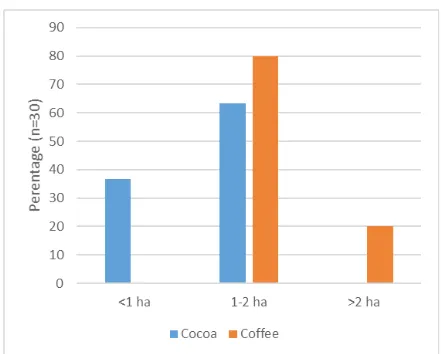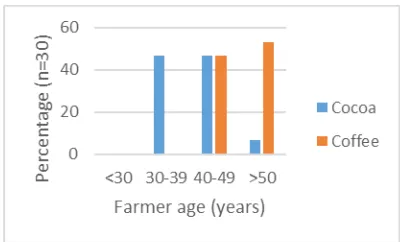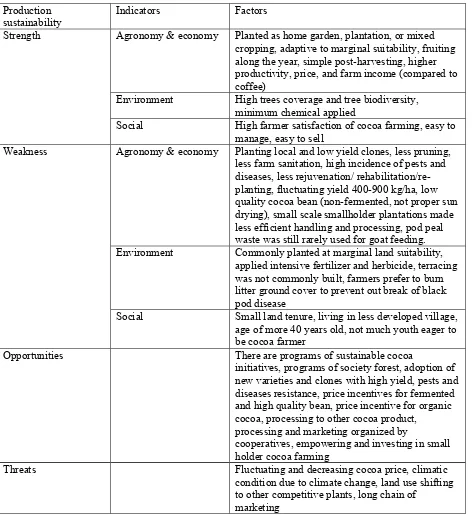COMPETITIVE AND SUSTAINABLE PRODUCTION OF COCOA IN TANGGAMUS, LAMPUNG PROVINCE, INDONESIA1
Rusdi Evizal*1, Fembriarti Erry Prasmatiwi2, Maria Christina Pasaribu2, Ivayani3, Lestari Wibowo3, Winda Rahmawati4, Agus Karyanto1
1Department of Agrotechnology, 2Department of Agribusiness,
3Department of Plant Pest and Disease, 4Department of Agricultural Engineering, Faculty of Agriculture University of Lampung
*Corresponding author Email: [email protected]
Lampung province is the 7th largest cocoa producers in Indonesia where 18,906 ha of them situated in Tanggamus Regency. This regency was the major producer of both coffee and cocoa. In the last 13 years, the coffee growing area decreased by 11.61% and its production decreased by 24.01%, meanwhile the cocoa growing area and its production increased by 400%. This study was aimed to explore the competitiveness and weakness factors of sustainable cocoa production in Tanggamus. The survey was taken at two sub-district of Tanggamus Regency which purposively sampled based on different land suitability. Field survey, interview, and focused group discussion were conducted in 2016-2017. Feasibility study was done in Bulok Sub-district using a total of 60 family samples.The finding showed that cocoa farming was more competitive than coffee farming for the following reasons: higher price (in 2008-2015 cocoa price was 20.12% higher than coffee price), higher farm income (Rp 12,808,551 compared to Rp 6,583,484) and higher ratio R/C (1.85 compared to 1.48). Beside coffee, cocoa land areas with moderate suitability and good market access could out compete the usage of land for other cash crops including fruits and vegetables that usually having high price. Nonetheless, the sustainability of cocoa production in Tanggamus faced some weaknesses i.e. low availability of high yielding planting materials and that resistant to pest and diseases, high incidence of pest and disease in the field, obstacles of replanting or rejuvenating old and less productive cocoa stands, variability of bean production, and low quality of unfermented bean and improperly drying. Key words: cocoa, coffee, competitive, production, sustainable
INTRODUCTION
Cocoa is important trade commodity of Indonesia, with export volume of cocoa bean in 2015 of 350,750 ton and value of 1,316 million US$. Lampung province is the 7th largest producers of cocoa in Indonesia, having 73,531 hectares of cocoa plantation, including in Tanggamus Regency with 18,906 ha. Lampung province is also the 2nd largest producers of coffee in Indonesia. Tanggamus has 17,919 ha of smallholder coffee plantation [1]. In Lampung, cocoa plantations were situated in 100-600 m above sea level [2] where coffee also planted. There were a dynamic of land use in Tanggamus between coffee (as a traditional commodity) and cocoa. In the last 13 years, coffee area decreased by 11.61% and production decreased by 24.01%,
1 Disampaikan pada “ISAE International Seminar 2017”, 9-12 August 2017, Bandar Lampung.
meanwhile cocoa area and production increased 400% (Table 1). Some farmers converted coffee plantation to cocoa plantation meanwhile others remained to plant coffee.
Table 1. Planted areal and production of coffee and cocoa in Tanggamus
Year Coffee Cocoa
Areal (ha) Production (t) Areal (ha) Production (t)
2002 51.814 40.242 3.774 2.079
2006 54.185 45.064 14.017 7.180
2009 54.256 45.342 14.314 7.180
2010 53.706 45.310 15.194 7.195
2012 53.105 44.639 17.081 7.404
2015 45.798 30.578 18.906 10.216
Source: BPS Kabupaten Tanggamus [7]
Sustainable cocoa production through expansion of cocoa land area and intensification for higher yield faced problems of land use change and low productivity of cocoa. The major causes of low yield are a high incidence of pests and diseases, the old age of cocoa farms, lack of soil nutrients and others improper management of cocoa plantation ([3],[2]). Forest to plant cocoa is scarce and conversion of the existing land use is not easy because there are many alternative crops such as coffee and rubber plant that may generate good income. Coffee plantation conversion to cocoa or coffee plant diversification was the response to low prices of coffee and the strategy to strengthen the income of coffee farmers [4].
Expansion of Indonesia cocoa planted area especially smallholder plantation increased significantly since 1987. Due to scarcity of forest area to plant cocoa, cocoa plantations were superimposed or diversified with other industrial crops such as coffee, coconut, rubber, and banana [2]. Among expansive commodities such as cocoa, rubber, and oil palm, some coffee plantations were survive. Plantations dynamic based planting period of replanting and new planting showed competitiveness of cocoa encouraged by the market [5].
Along with the vast development of new cocoa areas, the recent production and productivity of cocoa in Indonesia continues to a significant decline that threaten the sustainability of cocoa production. The decline in the quality and yield were influenced by many factors, among others, the attacks of infectious diseases and pests such as cocoa fruit borer Conophomorpha cramerella, plant materials, post-harvest and farming systems [6]. This research aimed to study (1) competitiveness of cocoa farming compare to coffee farming and (2) factors indicating sustainable cocoa production particularly in Tanggamus, Lampung, Indonesia.
MATERIAL AND METHOD
development indices where cocoa plantation is the main farming system followed by coffee plantation. Sumberejo representing a good access, more populated sub-district with high village development indices where cocoa is only secondary crop among many others such as coffee, fruits and vegetables. Land suitability of Bulok is not suitable – marginally suitable for cocoa and coffee. Land suitability of Sumberejo is marginally suitable – moderately suitable for cocoa and coffee (Table 2, Figure 1-2). Field survey, interview, and focused group discussion (FGD) was conducted in 2016-2017. Feasibility study was conducted in Bulok Sub-district using 60 family samples from 30 of each cocoa and coffee farmers. Data were analyzed using financial feasibility analysis and SWOT analysis.
Table 2. The characteristics of study site
Characteristics Bulok Sumberejo
Land area (km2)[7] 51.68 56.77 Topography Sloping (medium
gradient mountain)
Sloping (medium gradient hill) Altitude (m above sea level) 400-500 600-700 Population density (person/
km2) 405.3 576.3
Land suitability for cocoa [8] S3 – N S2-S3 Land suitability for coffee S3 – N S2-S3 Soil classification [8] Dystropepts,
hapludults
Dystropepts, humitropepts, tropaquepts Cocoa farming type Smallholder
plantation, cocoa is the main crop
Home-garden, cocoa is secondary crop
Cocoa land area (ha) 0.5-2.0 0.01-1.5
Figure 2. Map of cocoa land suitability in Bulok (red marked) and Sumberejo (green marked)[8]
RESULTS AND DISCUSSION
Land use shift
Basically coffee plantation of smallholders were the main farming system in Tanggamus including in Bulok and Sumberejo Sub-district. However alternative crops were developed driven by good price and demand. In Bulok Sub-District, some coffee land uses were shifted to cocoa by full conversion (coffee cleared to plant cocoa) or inter-planting coffee with cocoa. If cocoa trees were inter-planted at close spaced (3-4 m), coffee trees were gradually died due to light and nutrient competition with cocoa. In Sumberejo more coffee land uses were shifted to banana or papaya that offer higher income. Cocoa trees were planted at home-garden and at plantation as mixed crops. Farmers prefer to plant coffee inside Sumberejo Sub-district and as well outside sub-district closed to forest area.
Table 3. Land use share in Bulok and Sumberejo
2013 Bulok (ha) Sumberejo (ha)
Coffee 2,252 1,647
Cocoa 2,615 148
Black pepper 733 284
Coconut 539 594
Snake fruit 35 400
Mango 286 286
Durio 1,095 823
Banana 1,132 3,880
Upland field 1005 1036
Cocoa price
Farmers’ decision to plant cocoa were driven by high price and high productivity of cocoa plantation. In average of 2008-2015 cocoa price was 20.12% higher than coffee price (Figure 3). However, prices were volatile. FGD results noted that in 2017 cocoa and coffee price become closer that farmers remain to plant coffee. Coffee farmers concluded that coffee farming has low risk (price, pest and disease) yet low farming expenses (Table 4).Cocoa farmers noted that beside high price, bean yield may reach 1-2 ton/ha when cocoa plantations were under proper manage (mainly fertilizing, pruning, sanitation) and pods were bearing along the year with enough rainfall. Cocoa trees were prone to long dry season that makes leaves drop followed by high incidence of black pod disease. In contrast, coffee trees were prone to long wet season that makes failure of flowering and fruiting. Coffee flowers and fruits dropped when rainfall was accessed especially at night rainfall. FGD concluded that both coffee and cocoa were prone to extreme rainfall due to climate change.
Figure 3. Dynamic of cocoa and coffee price in 2008-2015
Table 4. Reasons of coffee change or not change to cocoa Satisfaction Factors Coffee not to change to cocoa
(% farmers, n=30) Coffee change to cocoa(%farmers, n=30) Coffee farmer
Farming risk is lower 53.33
Farming expenses is
lower 33.33
Influence of other
farmers 13.33
Cocoa farmer
Structure of cost and income of coffee and cocoa farming showed on Table 5. Cocoa farmers applied more manure, fertilizers (particularly urea and NPK compound), and herbicide than coffee farmers. Fertilizers were applied 2-3 times a year, at early and end of wet season to induce growth (after dry season) and bearing (before dry season). Cocoa plants were managed more intensive in term of manure, chemical, and labor resulted in higher production cost. However, due to higher yield productivity and higher price, cocoa farming generated higher revenue and farm income. In fact cocoa farming offered higher financial feasibility. Some farmers changed their coffee plantation to cocoa plantation hopefully to get higher income.
Table 5. Comparing cost and income of coffee and cocoa farming (ha-1)
Variables
NPK compound (kg) 78 233,333 186 450,000
TSP/SP36 (kg) 122 330,556 103 256,410
2. Land rent (ha-1) 2,000,000 2,000,000
3. Depreciation cost 13,825 20,938
Total (B) 2,657,003 3,965,639
C. Production cost (A+B)
8,155,824 10,435,325
D. Dry bean yield (kg) 680 903
E. Revenue 12,082,305 19,278,237
R/C 1.481 1.847
Farm income (E-A) 6,583,484 12,808,551
Net income (E-C) 3,926,481 8,842,912
Cocoa replanting
Farmers had changed their plantation to cocoa, but good agriculture practices for cocoa has not adopted yet. About 20% of cocoa trees were in age 15-19 years old that need to be rejuvenated. Moreover about 23% of cocoa trees were more than 20 years old that need to be replanted or rejuvenated. Farmers could manage old coffee tree to be cut, to be replanted or changed to another plant (Figure 4, coffee tree data of 15-19 years old was drop due to conversion), or to be rejuvenated by clonal grafting. Coffee plantations usually had good performance of pruning and grafting. In other handfarmers let old cocoa tree to grow older and higher with minimal pruning. Not much farmers pruned their cocoa trees and cloned it by side grafting or top grafting.
Figure 4. Age structure of coffee and cocoa plantation
shade management, and pest and disease control begin to decline to very low levels as reported by Curry et al. [11].
Table 6. Replanting/new planting cost of coffee and cocoa plantation (ha-1)
Cost variables Unit Coffee Cocoa
Amount Value (Rp) Amount Value (Rp) 1. Land clearing
Felling Man day 25 1,250,000 20 1,000,000
Cutting and stacking 6 300,000 7 350,000
2. Tillage
Hoeing 1 12 600,000 14 700,000
Hoeing 2 10 500,000 10 500,000
3. Seedling polybag 2,650 2,650,000 1,165 4,660,000
4. Planting
Manure ton 4 1,200,000 2 600,000
Holing and planting Man day 10 500,000 5 250,000
5. Maintenance
Hand weeding (3x) Man day 36 1,800,000 36 1,800,000
Herbicide(1x) liter 3 300,000 3 300,000
Herbicide spraying Man day 1 50,000 1 50,000
Fertilizer Urea,
Phonska (3x) kg 200 500,000 200 500,000
Fertilizer application Man day 12 600,000 9 450,000
Total cost 6,903,350 7,463,700
Cocoa multiple cropping
Figure 5. Cocoa and coffee farmers land tenure
We could found varieties of plant associated with cocoa trees in smallholder plantation including fruits, spices, and others. Banana, durio, and black pepper were the most commonly planted with cocoa in the area. Bananas had been planted since the establishment of cocoa plantation, functioning as shading plants and also as income generating. As cocoa trees canopy closed, banana partly eradicated and some clump were left. Banana clumps were thinned to leave a single tree and one ratoon tree.
Intercropping cocoa with banana significantly increased the yield of cocoa due structure effect of cocoa – banana [14]. In a degraded cocoa plantation with a long history of intensive fertilization, inter-planting with banana and shade trees had positive effects on cocoa yield probably linked with the creation of an environment that improves cocoa crop physiology and reduces pressure of pests and diseases [15]. Shading also beneficial as an adaptation measure for cocoa plantation to climate change [16].
Table 7. Farming income from multiple cropping
Variables Coffee multiple cropping Cocoa multiple cropping Intercrops (frequency, n=30) Banana (23), Durio (16),
black pepper (19), Parkia speciosa (14), coconut (3)
Banana (17), Durio (11), black pepper (10), Parkia speciosa (7), clove (3), Lansium domesticum (2), long pepper (1), coconut (1), mangosteen (1)
Revenue (Rp) 6,320,611 4,475,790
Farm expenses (Rp) 560,541 504,910
Farm income (Rp) 5,760,070 3,970,880
Farm income percentage to
cocoa (%) 87.5 31.0
Sustainable cocoa production
About 53% of cocoa farmer sample was above 40 years old (Figure 6). It was better than those of coffee farmers that 100% was above 40 years old. It seemed that being a farmer of cocoa or coffee plantation was not attractive for youth. During FGD no youth really willing to be cocoa farmers. They preferred to go to city and work as factory labor. If they failed living in the city, they might back home and work as a farmer, replacing their father take care of cocoa orchard.
Figure 6. Percent age distribution among cocoa and coffee farmer
High yielding cocoa planting materials were available mostly for every farmer groups. However local varieties and clones were commonly planted because its seedling price was lower. Farmers had experience that selected local variety could produce high yield. Unfortunately, unlike in coffee farming, pruning, grafting, rejuvenating, replanting were not commonly practiced yet in cocoa farming. Farmers produced unfermented cocoa bean with high water content. In rainy season, sun-drying take longer time to meet standard water content of dry bean unless cocoa bean became moldy and black.
Table 8. SWOT for sustainable cocoa production
Production sustainability
Indicators Factors
Strength Agronomy & economy Planted as home garden, plantation, or mixed cropping, adaptive to marginal suitability, fruiting along the year, simple post-harvesting, higher productivity, price, and farm income (compared to coffee)
Environment High trees coverage and tree biodiversity, minimum chemical applied
Social High farmer satisfaction of cocoa farming, easy to manage, easy to sell
Weakness Agronomy & economy Planting local and low yield clones, less pruning, less farm sanitation, high incidence of pests and diseases, less rejuvenation/ rehabilitation/re-planting, fluctuating yield 400-900 kg/ha, low quality cocoa bean (non-fermented, not proper sun drying), small scale smallholder plantations made less efficient handling and processing, pod peal waste was still rarely used for goat feeding. Environment Commonly planted at marginal land suitability,
applied intensive fertilizer and herbicide, terracing was not commonly built, farmers prefer to burn litter ground cover to prevent out break of black pod disease
Social Small land tenure, living in less developed village, age of more 40 years old, not much youth eager to be cocoa farmer
Opportunities There are programs of sustainable cocoa
initiatives, programs of society forest, adoption of new varieties and clones with high yield, pests and diseases resistance, price incentives for fermented and high quality bean, price incentive for organic cocoa, processing to other cocoa product,
processing and marketing organized by
cooperatives, empowering and investing in small holder cocoa farming
Threats Fluctuating and decreasing cocoa price, climatic condition due to climate change, land use shifting to other competitive plants, long chain of
CONCLUSIONS
In Tanggamus Lampung Province cocoa farming was more competitive than coffee farming for the following reasons: (1) higher price (in 2008-2015 cocoa price was 20.12% higher than coffee price), (2) higher farm income (Rp 12,808,551 compared to Rp 6,583,484) and (3) higher ratio R/C (1.85 compared to 1.48). Beside coffee, cocoa land areas with moderate suitability and good market access could out compete the usage of land for other cash crops including fruits and vegetables that usually having high price. The sustainability of cocoa production in Tanggamus faced some weaknesses i.e: (1) low availability of high yielding planting materials and that resistant to pest and diseases, high incidence of pest and disease in the field, (2) obstacles of replanting or rejuvenating old and less productive cocoa stands, (3) variability of bean production due to climatic situation, (4) producing low quality cocoa bean including no fermentation, mouldy bean and high water content, (5) small scale smallholder plantations made less efficient handling and processing, (6) youth generation had little interested in cocoa farming.
ACKNOWLEDGEMENT
The authors would like to thank to to the Directorate for Research and Community Service, Directorate General for Higher Education for funding through IbDM Grant of Community Service in year 2017.
REFERENCES
[1] Directorate General of Estate Crops. Tree Crop Estate Statistics of Indonesia 2014-2016 Cocoa. Ministry of Agriculture. Jakarta. 2016.
[2] R. Evizal, Sumaryo, N. Sa’diyah, J. Prasetyo, F.E. Prasmatiwi, I. Nurmayasari. Farm performance and problem area of cocoa plantation in Lampung Province, Indonesia. Conference Proceeding the USR International Seminar on Food Security. p. 193-205. 2016.
[3] M. Wessel and P.M.F. Quist-Wessel. Cocoa production in West Africa, a review and analysis of recent development. NJAS-Wageningen Journal of Life Science 74-75: 1-7. 2015.
[4] E.A. Ellis, K.A. Baerenklau, R. Marcos-Martinez, E. Chavez. Land use/land cover change dynamics and drivers in a low-grade marginal coffee growing region of Veracruz, Mexico. Agroforest Syst 80:61-84. 2010.
[5] F. Ruf. Diversification of cocoa farms in Cote d’Ivore: Complementary of and competition from rubber rent. In: F. Ruf and G. Schroth (eds). Economics and Ecology of Diversification. DOI 10.1007/978-94-017-7294-5_2. 2015.
[7] BPS KabupatenTanggamus. Tanggamus Dalam Angka. Kota Agung. 2016.
[8] PS Perencanaan Wilayah IPB Bogor. Peta Kesesuaian Lahan Komoditas Kopi dan Kakao Kabupaten Tanggamus. Bogor. 2007.
[9] D. Snoeck, R. Lacote, J. Keli, A. Doumbia, T. Chapuset, P. Jagoret, E. Gohet. 2013. Association of hevea with other tree crops can be more profitable than hevea monocrop during first 12 years. Industrial Crops and Products 43: 578-586. 2013.
[10] M.S. Beg, A. Ahmad, K. Jan, K. Bashir. Status, supply chain and processing of cocoa - A review. Trends in Food Science and Technology 66: 108-116. 2017
[11] G.N. Curry, G. Koczberski, J. Lummani, R. Nailina, E. Peter, G. McNally, O. Kuaimba. A bridge too far? The influence of socio-cultural values on the adaptation responses of smallholders to a devastating pest outbreak in cocoa. Global Environmental Change 35:1-11. 2015.
[12] M. Gross. Coffee and chocolate in danger. Currant Biology 24(11): 503-506. 2014
[13] P. Jagoret, O. Deheuvels, and P. Bastide. Sustainable cocoa production learning from agroforestry. Perspective Ecological Intensification (27): 1-4. 2014.
[14] O. Deheuvels, J. Avelino, E. Somarriba. Vegetation structure and productivity in cocoa-based agroforestry systems in Talamanca, Costa Rica. Agriculture, Ecosystems and Environment 149: 181-188. 2012.
[15] W. Vanhove, N. Vanhoudt, P. van Damme. Effect of shade tree planting and soil management on rehabilitation success of a 22-year-old degraded cocoa (Theobroma cacao L.) plantation. Agriculture, Ecosystems and Environment 219: 14-25. 2016.

